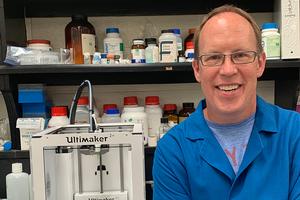Science
Metal Organic Frameworks and Printing

During his sabbatical last year, Dr. Matthew Hartings spent a lot of time at the National Institute of Standards and Technology (NIST) working on research he began in 2014.
This research is centered around metal organic frameworks and their ability to hold more density of gas than gas cylinders. Metal organic frameworks, otherwise known as MOFs, can be understood by using the concept of cars. In the process of attempting to create more environmentally friendly means of transportation, the idea of hydrogen-powered vehicles was created. MOFs are ideal for holding high amounts of hydrogen gas.
Hartings was inspired to work with MOFs because “they hold a lot of great potential for the type of chemistry they can do, and getting them to work on scale and apply them to real life is difficult.”
As a result, he is exceptionally proud of the fact that the work he and his partner have done “has helped push [them] from an academic setting to a useful way society can use them.”
Hartings began this process with the use of 3D printing. It would allow him to have control over the material, matrix, shape, and process. However, it is not a flawless science. Problems occur, such as not being to measure the gas uptake of the material in a 3D printing system due to the powder material.
There is also too much optimization involved in this research project. As a result, Hartings focuses on one aspect at a time. His latest goal is to figure out how to get complex geometries of high percentages of MOFs for applications of carbon dioxide. By completing one part of the project at a time, Hartings is able to improve his ideas to garner more accurate results.
In addition to using 3D printing for MOFs, Hartings also uses it for dental work. He has always been interested in creating 3D objects that do interesting things, such as chemical sensing, which prompted his interest in this project. He describes this as another example of a great collaboration between the two. Chemical sensing can report what the chemical environment is like for tissue engineering.
For the dental work he is doing for the American Dental Association, Hartings has created printing materials that have pH indicators in them. In the future, he hopes to create 3D printing material that can report back pH information of the tissue environment and how much calcium is in solution. He says he also hopes to find new applications no one has thought of before when combining these two research projects. Both aspects (MOFs and 3D printing) have lots of potential on their own, but together, new avenues open up.
Outside of research, Hartings acts as an undergraduate advisor for students in the chemistry department. Not only does he work with undergraduate students to talk about post-graduate plans, study abroad options, or the kind of classes to take, Hartings is also working to improve the biochemistry scheduling. At the moment, the biochemistry course is not American Chemical Society certified, but it is his goal to change that.
Hartings hopes to build a strong chemistry community by forming a club that would allow students to participate in fun labs, such as the photography lab and cooking lab, so that they may become more familiar with one another and potentially create a support system. He would also like to use this as an opportunity to gain the interest of other non-chemistry students. With the possibility of non-science majors also attending the photography and cooking labs, Hartings hopes that students will find that they enjoy science and want to pursue it as a major.